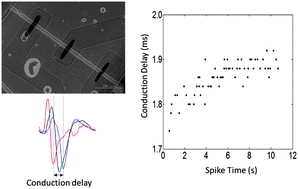Axonal conduction slowing induced by spontaneous bursting activity in cortical neurons cultured in a microtunnel device
Abstract
Recently, axons have been recognized as computational units in neuronal networks that can change their conduction properties along with their firing. However, little is known about the relationship between spontaneous activity and changes in the conduction velocity due to lack of a suitable method. Here, we studied changes in the conduction velocity during bursting activity using a new microfabricated device and the spike sorting method. The propagating action potentials were recorded from axons, which extended through a microtunnel in our device, comprised of a microfabricated chamber and a microelectrode array. By using waveforms recorded from a series of three electrodes along the bottom of a microtunnel, we achieved a sorting accuracy approximately 8.0% higher than that of the conventional one-electrode waveform method. We then demonstrated for the first time that conduction delays increased by 8.0% in action potentials of a mathematically isolated axon during one burst recorded at 10 days in vitro (DIV). Moreover, 79.4% of all clusters showed this conduction slowing during bursting activity at 10 DIV. Finally, we evaluated the days-in-culture dependence of the properties of bursting activity. These results suggest that our method is suitable for evaluating changes in conduction properties induced by spontaneous activity.


 Please wait while we load your content...
Please wait while we load your content...